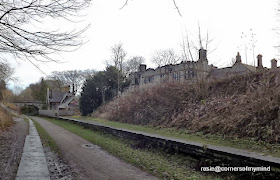A couple of weeks ago on our way back from a visit to Chesterfield we stopped off to photograph the church at the village of Ault Hucknall for Paul's one-name study website. I think this is one of the few churches where both our family names can be found as the name Limb, Limm and Lymm - found on my mother's side of the family also seems to originate from here. Whilst researching my ancestors over the years I've found clusters of the Limb (and variants) name in parish records from Ault Hucknall and Heanor in Derbyshire and Eastwood in Nottinghamshire.
The village of Ault Hucknall, described in some places as the smallest village in England as it has only three dwelling places and the church, is close to both Hardwick Hall and Stainsby Mill and isn't far from the village where I grew up in fact the two churches were recently and perhaps still are served by the same vicar. I think it is known as a dual benefice.
I was surprised that my photos turned out so well as it was getting quite dark in the gloom of a late winter's afternoon. The whole parish of Ault Hucknall includes the nearby settlements of Hardstoft, Rowthorne, Astwith and Stainsby as well as some outlying farmsteads.
According to the Victoria County History some of the features of the church of St John the Baptist, which is Grade 1 listed, date back to the 11th century when ecclesiastical architecture was still very much influenced by Anglo-Saxon traditions. As seen in the carvings above and below.
The church played an important part in the lives of all the people on the Hardwick Estate and some of them must have travelled quite a way to attend services there. Not surprisingly the church was closed whilst we were there but inside is buried the philosopher and author of The Leviathan Thomas Hobbes who was in his younger days a tutor to the Cavendish family.
The gravestones in the churchyard were most interesting and I'd like to return and look at them and the inside of the church at a later date. I thought the monument below look quite spooky in the half light.
I didn't spot any Limbs in the churchyard but I did see two on the War Memorial which stands just outside Stainsby Mill
We visited Stainsby Mill in April last year on a really cold day and I took a few photos which I never used on here. It is of course owned by the National Trust and run by volunteers.
It stands on the Hardwick Estate and its interpretation inside is that of a 19th century water mill.
Although from my photos it looks as if there was no one else there in actual fact there were quite a few people inside where the volunteers were describing the various workings of the mill and grinding handfuls of flour for us to feel.
























































